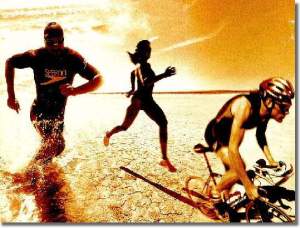Peaking in all three disciplines at once: Is it possible?
May 30, 2008 at 8:05 am Leave a comment
Well, according to the NY Times, apparently not. The article, which quotes Triathlon mastermind Joe Friel, basically says that the varying strains that the various disciplines put on your body make it nearly impossible for an amateur athlete to peak in all three at once (i.e. having a personal best in swimming, cycling, and running in the same race).
The article is worth a read if you’re at all interested in learning about how your body works.
One takeaway point might be to vary up your training schedule from time to time and really see how your body adapts to various strategies. For instance, if you give your legs two days off do they feel sluggish when you start a workout or do they feel fresh. If you go light on running one week, does your cycling improve?
These types of variations will allow you to customize your peak session for your races to your body. Ideally, one would like to peak in all three at once, but since that’s probably not possible, aiming to peak in cycling, running, and then swimming (in that order) is probably your best course of action. Since about 1/2 of the time in any give race is spent on the bike, it makes sense that you’d want your best time to be on the bike.
Additionally, if you can get off the bike with a good time and still have a little left in your legs to turn in a decent run, you’ll be in good shape. Take the following hypothetical into consideration:
You come out of the water with a ho-hum time because, well, let’s face it: you’ve accepted the fact that you’re not an olympic swimmer and you didn’t grow up swimming. You get on the bike and your legs feel good and by the end of the first mile, you’re churning away at 19 MPH. This is your speed. All your training rides have been at this speed and you know that you can push your average speed up to 20 MPH for the course of your half-ironman, but if you do, your run will suffer by 30 seconds a mile, or about 1/2 a mile an hour. What do you do? Well, give the distances you’re going, choosing to push it on the bike at the expense of the run will net you about 2 1/2 minutes over the course of the race.
Why is this important? Well think about it in real terms. A 1-2 MPH increase on the bike is pretty realistic and can be accomplished with minimal additional power output (especially if you find a way to make yourself more aerodynamic). A .5-1 MPH increase on the run, on the other hand, is much more difficult to do (think about kicking up the speed on the treadmill by that amount when you’re already tired…not so fun, huh?) Consequently, you’re better off pushing it a little on the bike at the expense of your run (as long as you don’t completely kill your run) since your legs will be fresh on the bike and you won’t have to worry about making it up on the run.
A perfect example of this idea is a comparison of two finishers in the Male 25-29 category at the most recent Ironman California 70.3 in Oceanside (the event I’ll be doing next April):
Racer # 1 had the following average paces: Swim: 1:47/100M; Bike: 20.5 MPH; Run: 8:00/mile (or about a 7.5 MPH pace)
Racer #2: Swim: 1:28/100M; Bike: 18.6 MPH; Run 7:11/mile (or about 8.35 MPH).
Racer #2 beat #1 out of the water and crushed him on the run, but finished behind #1 by nearly a minute in the race.
It should be noted that the time difference between the two racers can be attributed almost entirely to the time gap in T2, but still, the amount of work these two riders put into the various legs seems disproportionate to me. Maybe it’s just me, but personally, I’d much rather have to get my bike pace up 2 miles an hour over the course of 56 miles than get my run pace down by 50 seconds/mile over the course of 13 miles. Admittedly, if you have a background in running, the hypothetical and my conjecture go out the window. I’m approaching this from the perspective of somebody like myself (i.e. somebody who’s obviously done all three sports at varying points in his life, but none of them competitively). For these types of athletes, increasing cycling speed is typically much more realistic than increasing running speed significantly and as the numbers show, if you have to make a choice, choose cycling for the faster times.
Keep on Triing!
Entry filed under: Uncategorized. Tags: cycling, Ironman California, mile pacing, NY Times training article, Oceanside 70.3, peak training, running, Triathlon Training.

Trackback this post | Subscribe to the comments via RSS Feed